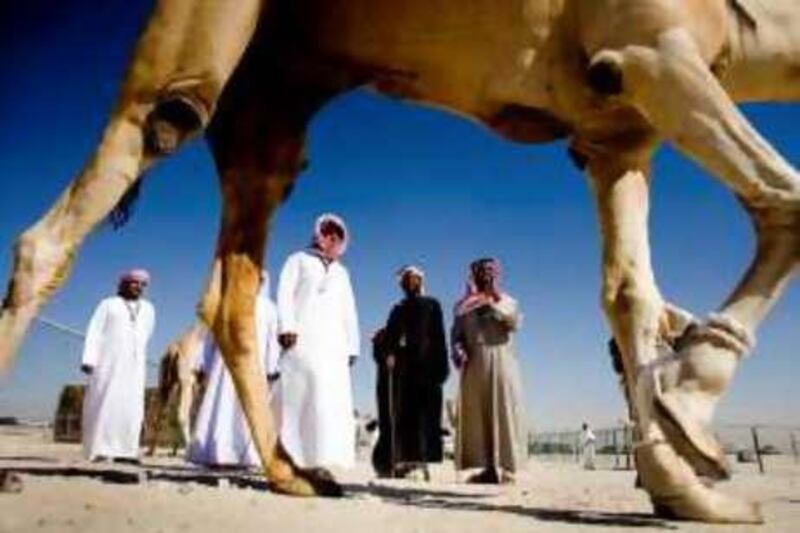MADINAT ZAYED, AL GHARBIA // A group of judges huddled in the middle of the central competition area comparing notes on the 10 towering camels tethered to the sides of the pen. After much deliberation, the results were announced in reverse order. The three most beautiful of the 10 finalists stood in front of the stands before the name of No 9's owner was announced to great applause. It was the first event of the mazayina, or camel beauty contest, at this year's Al Dhafra Festival. A light Asayel camel belonging to Sheikh Zayed bin Hamdan was declared the most beautiful in its class by the judges from the UAE, Kuwait, Qatar and Saudi Arabia.
As the winner was announced, gutras were thrown in the air and dozens of spectators rushed down onto the judging grounds. Some of them hoisted their canes in the air as they joined a traditional celebratory dance to music blaring from loudspeakers. Other winners on the first day of the second edition of the annual festival included Mabroukan, a camel belonging to Sheikh Mohammed bin Sultan, who bought the animal for a record Dh15 million at the first one in April. This year's festival will run until Jan 1. Yesterday, the stands were packed with hundreds of men of all ages from across the Gulf. The front row was reserved for VIPs including Sheikh Zayed, who was there to see his camel parade in front of the crowds with a bright white winner's cape draped over its back. On one side of the competition area dozens of lean, light Asayel camels stood with their handlers before entering the competition area. Opposite, the powerfully built, black Majahim camels waited for their turn before the judges, who would be looking for signs of beauty from their posture to the spacing between their toes. Salem al Ameri, the head of the judging committee, said they were interested in everything "from the head to the leg". "For example, the judges look at the neck and see how long it is," said Mr al Amrei, who owns 300 camels. "Personally, I like the Majahim because it is part of my tradition from my family and I grew up with them. Why? Because of the body itself, the long neck and the beauty of its head, its lips and ears."
Hamed al Ameri, a member of the festival's organising committee, said he was pleased with the outcome of the first day of the event, which he called a way of celebrating animals that have " given so much". "Camels are in our blood," he said. "They have been for a long time and they will continue to be. Now we are returning what they gave to us as a celebration. Some people love the camels like their own children." This was a sentiment echoed by Obaid al Derri, 23, who travelled from Al Ain with several family members and some of their camels. "If you love them and treat them well, they will love you," he said. Like many other participants, the al Derri family set up camp along Million Street, or Shariah al Million, where they hoped to attract buyers for their animals. "Camels provide us with everything, from fertiliser to transportation, meat, medicine and milk," said Ali Hamad al Derri, before leaping onto the back of one of his camels, all of which have brands on their necks indicating they belong to his tribe. Some of the al Derri camels will also take part in auctions running throughout the festival. Meanwhile, adjacent to the vast festival site, a three-day falconry competition was winding down. Large birds flew along a 400-metre desert course, with sensors at each end measuring their speeds, as rapt spectators, owners and breeders looked on.






